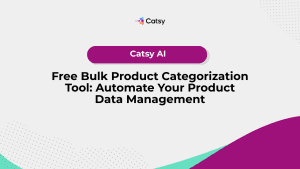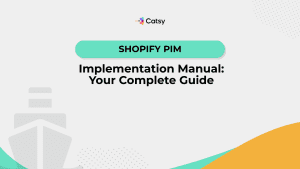PIM Governance: Establishing Data Standards
PIM Software Best Practices
- Ceejay S Teku
- October 4, 2025
- 4:47 am

Table of Contents
What You'll Learn:
- How PIM governance transforms chaotic product data into strategic business assets
- Essential framework components for establishing bulletproof data standards
- Proven implementation strategies that reduce data errors by 20 to 30 percent
- ROI measurement techniques showing average returns of 3 to 5x within 18 months
- Future-ready governance approaches for AI and automation readiness
1. Understanding PIM Governance Fundamentals
The technical reality: PIM governance is the very constitution of your organization’s data. It’s what tells your systems who owns what info, how that information flows, and what standards everyone is expected to follow.
Why it matters: Poor data governance has been shown to cost organizations an average of $12.9 million annually … all because of compliance failures, reworking to fix errors, and stalled AI initiatives. Without governance, even the most sophisticated product information management system becomes nothing more than a glorified spreadsheet.
Modern PIM governance addresses three critical pillars:
Data Quality Standards: These ensure that all of your data is complete and accurate before it’s syndicated with your storefronts.
Access Control determines who can create, edit, and approve your valuable product data… and who can’t.
Compliance Management handles your regulatory requirements and provides you with the appropriate audit trails.
The big picture: Organizations with established governance frameworks experience 66 percent better data security and 52 percent fewer compliance breaches, according to Gartner research. As you might imagine, this translates to a huge cost savings, simply due to operational gains.
User impact: Your teams can expect to spend 40 percent less time searching for the correct product information when you have properly implemented governance standards. Now your data stewards can focus on enriching your content … not on cleanup activities.
2. Building Your Data Standards Framework
Data complexity: Product information spans dozens of attributes across multiple categories. When you don’t standardize your data, your variants will multiply that chaos exponentially.
Start with attribute definitions that specify precisely what’s contained in each of your data fields. Then, create taxonomy structures that keep your products organized in a way that’s consistent across each of your sales channels. Finally, establish validation rules that’ll prevent bad data from entering your system in the first place.
Implementation timeline: Implementation may look different for different companies. In most cases, though, you should begin with your highest-impact products, mapping the data you have against the new standards you’ve created. From there, you can document the gaps you find and then prioritize your cleanup activities based on the value that fixing the issues will bring to your business.
The bottom line: If your company follows industry standards like ETIM, GS1, and BMECat, you can expect to see 30 percent faster implementation times and better marketplace integration capabilities than competitors who don’t will experience.
System requirements: At a minimum, your PIM should support configurable validation rules, automated quality scoring, and real-time compliance monitoring. As you shop for a PIM, look for platforms with built-in workflow engines and role-based permissions… you’ll thank us later!
Between the lines: Standards without enforcement are nothing more than mere suggestions. Automated validation will catch your errors before they impact the customer experience… or sabotage your compliance audits. Understanding how data governance optimizes product content marketing is critical to maintaining an advantage over the competition!
3. Implementing Governance Controls and Workflows
Workflow changes: Traditional, “ad-hoc” data entry gives way to structured approval processes. In the beginning, this can slow down your content creation processes, but don’t be discouraged! Over the long run it will improve your data quality dramatically.
We strongly suggest that you deploy automated quality checks that will score the completeness and accuracy of your data. Next, configure approval workflows that will route all of your changes through the appropriate stakeholders as they need them, and only those stakeholders. Set up audit trails that track each and every modification for compliance purposes.
Integration challenges: Legacy systems often lack governance capabilities. When this happens, APIs become critical for maintaining standards across your entire tech stack. So, with that said, your PIM platform must integrate seamlessly with your legacy ERP, DAM, and e-commerce systems.
ROI breakdown: Organizations typically see 20 to 30 percent reduction in data-related errors within six months of implementing structured governance controls.
Compliance requirements: GDPR, CCPA, and industry-specific regulations require that you provide clear data lineage and retention policies. Your governance framework should accommodate these automatically, and this’ll save you time and legal trouble later.
What’s next: As governance matures, your focus will shift from reactive cleanup to proactive prevention. Machine learning algorithms can predict quality issues before they become an issue for your customers.
4. Measuring Success and ROI
By the numbers: Data governance investments typically generate 3 to 5 times ROI within 18 months, with an average annual savings of $2.4 million. This is through reduced compliance costs and operational efficiency.
You’ll want to track your own data quality scores across key metrics like completeness and consistency.
Monitor your time-to-market improvements as you complete new product launches.
Make sure you also measure user adoption rates and error reduction percentages.
The technical reality: Modern governance platforms provide real-time dashboards that show coverage metrics, incident tracking, and business impact measurements. Automated reports like these will eliminate the overhead (and error) associated with manual reporting.
You’ll see some direct benefits, of course. These direct benefits include fewer compliance fines, reduced costs to fix data breaches, and overall savings from more streamlined operations.
Indirect benefits may display themselves in the form of improved decision-making, an enhanced customer experience, and accelerated AI initiatives.
Go deeper: The most advanced organizations will correlate their governance maturity with (mostly) predetermined, specific business outcomes. As you evaluate, consider factors like revenue growth, improved customer satisfaction, and your success rates as you expand into new markets.
The top companies using comprehensive governance strategies report a 58 percent improvement in data analytics quality and 57 percent increased cross-departmental collaboration, according to Precisely research.
5. Future-Proofing Your Governance Strategy
What’s next: AI and machine learning are being tasked with handling more and more routine governance processes. In fact, by 2026, you can expect 80 percent governance coverage through intelligent automation rather than through manual oversight.
Driving the news: You may have noticed that regulatory pressure is intensifying globally. GDPR fines reached €2.1 billion in 2024, while new EU regulations are expected to impact over 50,000 companies by 2026.
Scalability factors: Cloud-native governance platforms can adapt automatically even as your data volume increases. Edge computing and data democratization require a distributed governance model, not centralized control.
API limitations: Legacy governance approaches can’t handle modern data velocities. Real-time governance through streaming architectures is now a must-have for a competitive advantage.
The big picture: Organizations are making a necessary shift from reactive compliance to proactive data intelligence. Governance is becoming an enabler for innovation – as opposed to a barrier to agility.
Between the lines: Companies that treat governance as purely technical infrastructure miss out on strategic opportunities! The winners are the companies that integrate governance into their business strategy from day one.
Key Takeaways
Foundation First: Establish clear data standards and ownership before you start implementing PIM technology. Governance frameworks must align with business objectives and regulatory requirements… and they’ll keep your teams from becoming overwhelmed.
Automation Advantage: Leverage automated validation, quality scoring, and workflow management to scale governance without the need to invest more money.
ROI Reality: Expect 3 to 5 times returns within 18 months. You’ll see this in cost avoidance, greater efficiency, and creation of business value! Be sure to track both your quantitative metrics and your qualitative success stories.
Future Focus: Get ready for AI-driven governance and distributed architectures on an ever-evolving regulatory landscape. Remember: governance is a competitive advantage when it’s used strategically!
FAQs:
How long does PIM governance implementation typically take?
Most organizations will see basic governance coverage in three to six months. Mature frameworks develop over 12 to 18 months. Your success will depend on your data complexity, your organization’s readiness, and on automation capabilities.
What's the biggest governance implementation challenge?
By far, it’s “cultural resistance” to process changes. Your teams are used to doing things one way and may take a moment to embrace new methods. Offer clear communication of the benefits and roll your implementation out gradually – don’t overwhelm your teams.
Can small organizations afford comprehensive PIM governance?
Modern, cloud-based platforms enable 80 percent or higher governance coverage – with minimal dedicated resources through intelligent automation. ROIl typically justifies investment within the first year due to efficiency gains alone!
How does governance impact day-to-day PIM operations?
Initial changes to your processes may slow down your content creation by about 10 to 15 percent. But mature governance will reduce overall operational overhead by as much as 30 to 40 percent through automation and error prevention.
What governance features are essential for AI readiness?
Automated data lineage, quality scoring, metadata management, and real-time validation become critical as AI initiatives require trusted, contextual data foundations for success.
Ceejay S Teku
Consider multi-store architecture when you are facing significant regional product variations. Complex compliance requirements and distinct customer segments should also be considered.
Typically, manufacturing businesses will benefit from multi-store approaches. This is especially true if you’re serving markets with different safety standards or regulatory requirements. Remember, too, that business-to-business and business-to-consumer customers will have fundamentally different purchasing processes.
Effective inventory management requires integration between your stores and your legacy systems. This usually involves middleware solutions.
You can synchronize your stock levels, coordinate fulfillment, and manage your regional allocation strategies. The key lies in maintaining real-time visibility across each of your channels while enabling flexible fulfillment.
The primary challenges you may face include management of safety standards, tech documentation, and environmental regulations. Proper customs and import documentation may also come into pay.
Each market may require different certifications, testing procedures, and ongoing compliance monitoring, and these must be integrated into your multi-store operations.
The primary challenges you may face include management of safety standards, tech documentation, and environmental regulations. Proper customs and import documentation may also come into pay.
Each market may require different certifications, testing procedures, and ongoing compliance monitoring, and these must be integrated into your multi-store operations.





